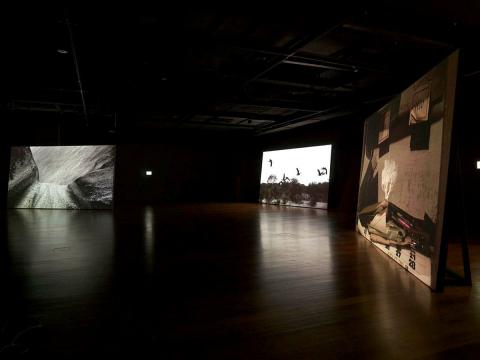ESSAY: Hiraki Sawa’s O
By Reuben Keehan
‘We Can Make Another Future’ September 2014
For those who have travelled in the Northern Territory and witnessed the central Australian landscape, the experience is often described as transformative. There is little to compare to the silence and vastness — the ragged beauty and an overwhelming sense of archaic time. While home to Indigenous Australians for millennia, white Australia’s relationship with this seemingly barren and harsh landscape has tended to be characterised, particularly in visual art, film and literature, by hostility, fear and alienation. Increasingly, however, these places are seen as tourist destinations of choice and are marketed as such as eco-vacations and adventure holidays, representative of experiencing the quintessential ‘heart’ of Australia.
For Japanese-born and, since 1996, London-based artist Hiraki Sawa, ten days spent camping in the desert around Alice Springs in 2009 was a unique and catalysing event, which fed directly into the creation of his multi-channel video and sound installation O, commissioned for ‘The 6th Asia Pacific Triennial of Contemporary Art’ in 2009.
Following a series of multi-screen video installations begun around 2006 by the artist, O is a more complex work in its combination of large- and small-screen formats, sound and light. It is an immersive piece comprising ten short films displayed on small screens; a triptych of larger videos projected onto floor-standing, angled screens; and a series of rotating speakers, which disperse an evocative and subtle soundscape throughout the installation.
Sawa has described his experience of the Australian desert as ‘extreme’,1 and it took some time for the video footage from the trip to coalesce and find its place in this work. The extremity of this episode was most acutely felt in terms of its dramatic contrast with Sawa’s urban-based life. The footage — of reflections, horizons, trees, sky, water, ancient eroded landforms, a luminescent moon and black cockatoos in flight — plays a major signifying role as it is poetically edited, fused and integrated into the overall moving-image montage of the installation. The accompanying ten small monitors display black-and-white footage of domestic objects, such as cups, jugs, a brass bell, a light bulb — spinning like tops and generating their own peculiar acoustic soundtrack as they endlessly pirouette. Though the footage is predominately black and white, muted colour is introduced through the inclusion of interior scenes of an abandoned, centuries-old house in the south of France. These images of dilapidated walls, accumulated detritus and domestic objects, such as clocks, books and candelabra, are mysteriously animated with shadowy miniature images of a Ferris wheel, the moon, a flock of birds and a ship sailing in a porcelain sink.
The accumulated effect of this montage of stillness and subtle movement evokes a tangible sense of time passing. The vast cosmic cycle of the earth and moon is brought into poetic play with a domestic human register, imbued with memory, melancholy and temporality.
The artist’s emblematic title, O, provides a key to engaging with the work. The installation is roughly circular and the revolving speakers, spinning objects and cycles of imagery echo across the three large screens and the synchronised eight‑minute loop of the entire work. In O, Hiraki Sawa begins at the end, invoking the circle as a visual metaphor together with cycles of time and movement as defining conditions for human action, memory and imagination.
Endnote
- See ‘APT6: Hiraki Sawa Artist Talk’, 15 December 2009, QAGOMA Youtube, viewed 15 May 2014.
Connected objects

O 2009
- SAWA, Hiraki - Creator
Related artists
SAWA, Hiraki
1977
- present
Full profile
for SAWA, Hiraki
Metadata, copyright and sharing information
About this story
- Subject